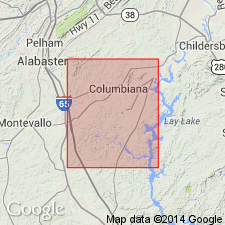
- Usage in publication:
-
- Buxahatchee Creek Member
- Modifications:
-
- Named
- Dominant lithology:
-
- Slate
- AAPG geologic province:
-
- Piedmont-Blue Ridge province
Summary:
Waxahatchee Slate of Kahatchee Mountain Group is here subdivided into newly named Buxahatchee Creek Member and overlying Long Branch Sandstone Member. The lowest part of the Buxahatchee Creek consists of interlayered dark-gray-green and very dusky-red slate and arenaceous slate. Layering is defined by alternating thin beds and laminae of different grain size and color. Middle to upper part of the member is composed of dark-gray, dark-green, and black arenaceous sericite slate with common fine-grained pyritic sandstone laminae. Upper part includes dark-gray thin-bedded very fine-grained limestone beds and claystone laminae. Also present in upper part is black to dark-gray claystone containing matrix-supported rounded fine- to medium-grained dark quartz clasts. Percentage of sandstone increases up section until it becomes the dominant rock type. Structural thickness is 4,242 ft in the western part of the study area where unit is tightly folded and lower contact is absent due to faulting. Age of the Waxahatchee and its members is shown as late Precambrian(?).
Source: GNU records (USGS DDS-6; Reston GNULEX).
For more information, please contact Nancy Stamm, Geologic Names Committee Secretary.
Asterisk (*) indicates published by U.S. Geological Survey authors.
"No current usage" (†) implies that a name has been abandoned or has fallen into disuse. Former usage and, if known, replacement name given in parentheses ( ).
Slash (/) indicates name conflicts with nomenclatural guidelines (CSN, 1933; ACSN, 1961, 1970; NACSN, 1983, 2005, 2021). May be explained within brackets ([ ]).

